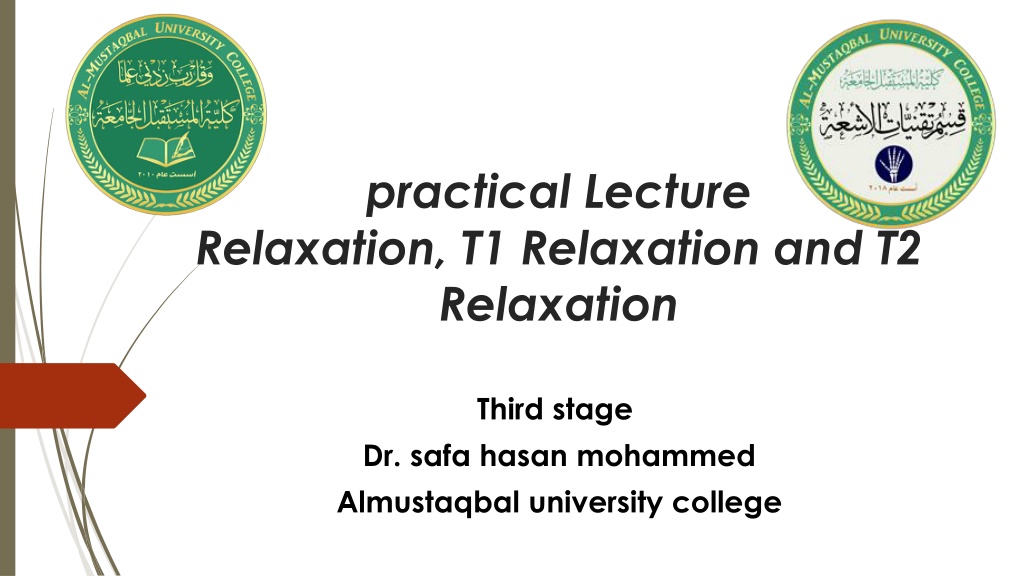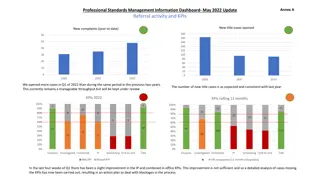
Understanding T1 Relaxation in MRI Imaging
Learn about T1 relaxation in MRI imaging, where the perturbed system returns to equilibrium. Discover the significance of T1 relaxation time, magnetization recovery, and the process of spins aligning with the Z-axis post-RF pulse. Dive into the details of how the net magnetization regrows along the Z-axis, emitting RF waves to return to the original equilibrium state.
Download Presentation

Please find below an Image/Link to download the presentation.
The content on the website is provided AS IS for your information and personal use only. It may not be sold, licensed, or shared on other websites without obtaining consent from the author. If you encounter any issues during the download, it is possible that the publisher has removed the file from their server.
You are allowed to download the files provided on this website for personal or commercial use, subject to the condition that they are used lawfully. All files are the property of their respective owners.
The content on the website is provided AS IS for your information and personal use only. It may not be sold, licensed, or shared on other websites without obtaining consent from the author.
E N D
Presentation Transcript
practical Lecture Relaxation, T1 Relaxation and T2 Relaxation Third stage Dr. safa hasan mohammed Almustaqbal university college
relaxation The relaxation means the return of a perturbed system into the original situation "equilibrium" and each relaxation process can be characterization by a relaxation time. The relaxation process can be divided into two parts: T1 and T2 relaxation.
T1 Relaxation T1 relaxation describes what happens in the Z direction. T1 is spin-lattice relaxation time which relates to the recovery of the magnetization along z direction after RF pulse. We can say that this as the time it takes tissue to recover from an RF pulse so you can give another pulse and still get signal. T1 is called the spin-lattice relaxation time because it refers to the time it takes for the spins to give the energy they obtained from the RF pulse back to the surrounding tissue (lattice) in order to go back to their equilibrium state.
T1 Relaxation after a little while, the situation is exactly as before we sent an RF pulse into the patient. the RF pulse is turned off. Therefore, after the RF pulse is turned off, two things will occur: 1. The spins will go back to the lowest energy state. 2. The spins will get out of phase with each other.
T1 Relaxation The Protons are return to its original situation "equilibrium" by the releasing the absorbed energy in the form of "very little" warmth and RF waves. That means, in principle the net magnetization rotates back to align itself with the Z-axis. After the stops of the RF excitation pulse, the net magnetization will re-grow along the Z-axis, while emitting radio-frequency waves,.
T1 Relaxation Figure 1: The net magnetization will re-grow along the Z- axis after the stops of the RF excitation pulse
T1 Relaxation The recovery of MZ versus time is given by the relation: MZ (t) = Mo(1 ? ?/??) where, MZ is the longitudinal magnetization that recovers after a time t, with relaxation constant T1. When t = T1, then 1-? ?= 0.63 and MZ = 0.63 Mo. Full longitudinal recovery depends on the T1 time constant. Time equal to 3 T1, after 90 pulse, 95% of the equilibrium magnetization is established. It takes 5 T1 time, to return back to the full magnetization.
T1 Relaxation T1 relaxation is a time constant. T1 is defined as the time it takes for the longitudinal magnetization (MZ) to reach 63 % of the original magnetization. Spin-lattice Figure relaxation time. Longitudinal magnetization undergoes growth with corresponds that have 63% growth of Mz 2: exponential time. the T1 to time,
T1 Relaxation T1 relaxation happens to the protons in the experienced the 90o-excitation pulse. However, not protons are bound molecules in the same way. This is different for each tissue. One 1H atom may be bound very tight, such as in fat tissue, while the other has a much looser bond, such as in water. Tightly bound release their quicker to their surroundings than protons, which are bound loosely. The rate at which they release their energy is therefore different. The relaxation can be depicted as shown in Figure 3. volume that all in the their protons energy will much Figure 3: Example T1 curves for four tissues found in the head. rate of T1
T1 Relaxation Table 1. Variation of T1 time with magnetic field strength, for various biological tissues
T2 Relaxation T2 relaxation describes what happens in the X-Y plane. right after the 90o RF pulse the net magnetization vector (now called transverse magnetization) is rotating in the X-Y plane around the Z-axis at the Larmor frequency (figure 4). transverse magnetization formed by tilting the longitudinal magnetization into the transverse radiofrequency pulse. The transverse magnetization induces an MR signal in the radiofrequency coil immediately after its formation, it has a maximum magnitude, and all of the protons are in phase. plane by using a
T2 Relaxation Therefore the vectors all point in the same direction because they are in-Phase. The transverse magnetization starts decreasing in magnitude immediately as protons start going out of phase. This process of de-phasing and reduction in the amount of transverse magnetization is called transverse relaxation. It is the time taken to reduce the transverse magnetization vector to 37% of the peak value (figure 5).
T2 Relaxation Figure 4: De- phasing and free induction decay (FID).
T2 Relaxation The transverse and equilibrium vector is given by the relation, MXY(t) = Mo? ?/?? time representing the decay of the signal by 1/e, or 37%, is called the T2 relaxation time. 1/T2 is referred to as the transverse relaxation rate. This process of getting from a situation to a total out-of-phase situation is called T2 relaxation. total in-phase Figure 4 : Spin-spin relaxation: Transverse magnetization undergoes exponential decay.T2 corresponds to time that have 37% of Mxy
T2 Relaxation The rate of de-phasing is different for each tissue. Fat tissue will de-phase quickly, while water will de-phase much slower (figure 6). Figure 6: Transverse magnetization decay (T2)
Remarks T2: it happens much faster than T1 relaxation. T2 relaxation happens in tens of milliseconds, while T1 can take up to seconds. T2 relaxation is also called spin spin relaxation because it describes interactions between protons in their immediate surroundings (molecules).
T2* Relaxation Time Extrinsic magnetic inhomogeneities make loss of phase coherence more rapidly than from spin-spin interactions. When external magnet s (Bo) inhomogeneity is considered, the spin-spin decay constant T2 is reduced to T2* (figure 7). The T2* depends on the homogeneity of the main magnetic field and presence of susceptibility agents (contrast material) in the tissue.
T2* Relaxation Time Figure 6: T2 decays with intrinsic magnetic in- homogeneities and T2* decays with both intrinsic and extrinsic magnetic inhomogeneities
Table 2: Approximate spin density (SD) and relaxation times (Tl, T2) for various tissues.
Discussion Q1: What are T1 and T2? Q2: why T1 is called spin-lattice relaxation? Q3: Why T2 is called spin- spin relaxation ? Q4: What is the reason that the T1 are different from tissue to another? Q5: Why T1 for fat is shorter that T1 for water? Q6: why T1 increases with increasing magnetic field














